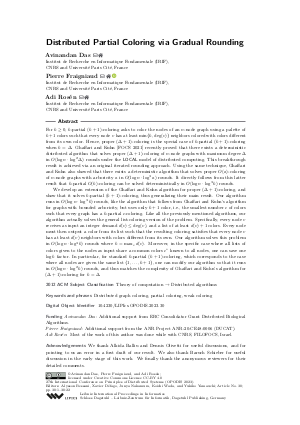@InProceedings{das_et_al:LIPIcs.OPODIS.2023.30,
author = {Das, Avinandan and Fraigniaud, Pierre and Ros\'{e}n, Adi},
title = {{Distributed Partial Coloring via Gradual Rounding}},
booktitle = {27th International Conference on Principles of Distributed Systems (OPODIS 2023)},
pages = {30:1--30:22},
series = {Leibniz International Proceedings in Informatics (LIPIcs)},
ISBN = {978-3-95977-308-9},
ISSN = {1868-8969},
year = {2024},
volume = {286},
editor = {Bessani, Alysson and D\'{e}fago, Xavier and Nakamura, Junya and Wada, Koichi and Yamauchi, Yukiko},
publisher = {Schloss Dagstuhl -- Leibniz-Zentrum f{\"u}r Informatik},
address = {Dagstuhl, Germany},
URL = {https://drops.dagstuhl.de/entities/document/10.4230/LIPIcs.OPODIS.2023.30},
URN = {urn:nbn:de:0030-drops-195205},
doi = {10.4230/LIPIcs.OPODIS.2023.30},
annote = {Keywords: Distributed graph coloring, partial coloring, weak coloring}
}

 Creative Commons Attribution 4.0 International license
Creative Commons Attribution 4.0 International license

